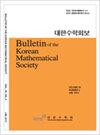若干t型相交家族的多样性
IF 0.5
4区 数学
Q3 MATHEMATICS
引用次数: 0
摘要
令[n] ={1,2,…, n}和2[n]是[n]的所有子集的集合。对于一个族F∈2[n],其多样性用div(F)表示,定义为div(F) = min x∈[n] {|F(x)|},其中F(x) = {F∈F: x /∈F}。基本上,div(F)测量的是F到一个平凡相交族的距离,这个族被称为星形。本文考虑了t相交族的分集性的推广。本文章由计算机程序翻译,如有差异,请以英文原文为准。
On diversity of certain T-intersecting families
Let [n] = {1, 2, . . . , n} and 2[n] be the set of all subsets of [n]. For a family F ⊆ 2[n], its diversity, denoted by div(F), is defined to be div(F) = min x∈[n] {|F(x)|} , where F(x) = {F ∈ F : x / ∈ F}. Basically, div(F) measures how far F is from a trivial intersecting family, which is called a star. In this paper, we consider a generalization of diversity for t-intersecting family.
求助全文
通过发布文献求助,成功后即可免费获取论文全文。
去求助
来源期刊
CiteScore
0.80
自引率
20.00%
发文量
0
审稿时长
6 months
期刊介绍:
This journal endeavors to publish significant research of broad interests in pure and applied mathematics. One volume is published each year, and each volume consists of six issues (January, March, May, July, September, November).

 求助内容:
求助内容: 应助结果提醒方式:
应助结果提醒方式:


